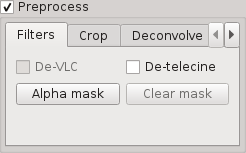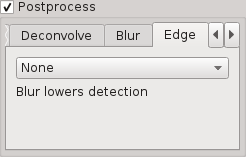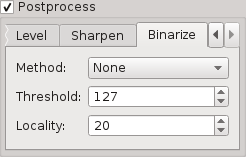-
Notifications
You must be signed in to change notification settings - Fork 14
Manual | Pre and post processing
These options gets applied to the images as soon the image is added, before the images are aligned. If you make a mistake, you have to clear the images and start over again. (Might be improved in the future.)

Alpha mask
Select an image with "Alpha mask" which will be applied as the alpha channel to the next added images. Black areas will be transparent, white opaque, and gray partially transparent. The mask must have the same dimensions as the images. Click "Alpha mask" again to replace it, or "Clear mask" to prevent it to affect further images.
de-telecine
Performs reverse telecine (IVTC). The latest image is not always added immediately, in order to potentially merge it into the next half frame.
Note that this process only works well on YUV images, as the half-frames gets mixed together in the RGB conversion.

Crops the images, x pixels from the top, left, right and bottom. YUV images gets cropped with 2*x pixels to keep the sub-sampled planes aligned.

De-blurring using Richardson–Lucy deconvolution.
Deviation
The amount of blurring in the image. Values of 0.600-0.700 often works well. Too high values causes ringing, and too low values results in little affect.
Iterations
How well the de-blurred image is estimated. Higher values causes linear slowdown and very high values might cause noise artifacts. A value of 10 is usually fine.

Select scaling algorithm using the dropdown menu. (Doesn't actually work yet: #7 Scaling drop-down boxes are not handled )
Nearest, Nearest neightbour - Quick, but very poor scaling, resulting in a blocky output
Linear, Linear interpolation - Low quality smoothed scaling
Cubic, Cubic interpolation (also known as bicubic) - Decent quality scaling, providing a good balance between several scaling artifacts.
The two spinboxes control horizontal and vertical scaling factor respectably. Scale chroma (YUV only) upscales subsampled chroma channels to have the same resolution as the luma channel.
Affects the stitched image after pressing Draw. After modifying any option, click Draw again to see the affect. For YUV images, many of these options only affects the lumi channel.
Same as Preprocessing, though Scale chroma is not available.
Same as Preprocessing

Blurs the image, using the specified amount/size in pixels. Two blurring algorithms are available:
Box - Blurs the image quickly by using a hard rectangular area ("box"). Can cause blocky artifacts.
Gausian - Blurs using a gausian bell curve, which provides good, artifact free blurring. Can be slow with large blurring sizes.

Performs edge-detection on the image. Blurring the image previously reduces the amount of found edges, and their strength. Several algorithms are available:
Robert and Prewitt - Very simple, but effective
Sobel - Slightly better than Robert and Prewitt
Laplacian - Produces very strong edges, but tends to pick up noise. (5) is a stronger version of (3).

Corresponds to the Levels tool in Gimp. Used to control how the values are distributed over the values range.
Limit
Cut off values below the left value, and above the right value, restricting them to that range.
Gamma
Changes brightness using a gamma curve. Values below 1.0 brightens images, while values above 1.0 darkens the image
Out
Changes the resulting range of values. Zero will be equal to the left value, 255 will be equal to the right value, and any other value will be linear interpolated between the two.
You can set these two values to 255 and 0, to invert the colors.

Binarizes the images to contain only two colors, black and white, without any gray colors.
The spinboxes makes little sense and have different meanings depending on the algorithm.
Threshold
Any value below the threshold is black, above is white. locality performs binary dilation which expands the black areas.
Adaptive
Takes the average color in a locality sized area, and uses that as threshold. thresholds adds that value to the local threshold and should be around zero for best results!.
This method requires a bit of fiddling to the parameters, but produces good, almost edge-detecting binarization.
Dither
Tries to simulate gray scale images using only black and white, switching back and forth between the two colors in a systematic manner. The result should be viewed in 1:1 scale. (The spinboxes have no effect.)